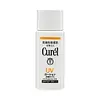What's inside
What's inside
 Key Ingredients
Key Ingredients

 Benefits
Benefits

 Concerns
Concerns

No concerns
 Ingredients Side-by-side
Ingredients Side-by-side

Water
Skin ConditioningHydrogenated Polyisobutene
EmollientDimethicone
EmollientGlycerin
HumectantButyrospermum Parkii Butter
Skin ConditioningPanthenol
Skin ConditioningZea Mays Starch
AbsorbentPropanediol
SolventButylene Glycol
HumectantCetyl PEG/PPG-10/1 Dimethicone
EmulsifyingTrihydroxystearin
Skin ConditioningCentella Asiatica Leaf Extract
Skin ConditioningPolymnia Sonchifolia Root Juice
Skin ConditioningZinc Gluconate
Skin ConditioningMadecassoside
AntioxidantManganese Gluconate
Skin ConditioningAlpha-Glucan Oligosaccharide
CleansingSilica
AbrasiveAluminum Hydroxide
EmollientMagnesium Sulfate
Mannose
HumectantCapryloyl Glycine
CleansingCaprylyl Glycol
EmollientVitreoscilla Ferment
Skin ConditioningCitric Acid
BufferingTrisodium Ethylenediamine Disuccinate
Lactobacillus
Skin ConditioningAcetylated Glycol Stearate
EmollientMaltodextrin
AbsorbentPolyglyceryl-4 Isostearate
EmulsifyingTocopherol
AntioxidantPentaerythrityl Tetra-Di-T-Butyl Hydroxyhydrocinnamate
AntioxidantTitanium Dioxide
Cosmetic ColorantWater, Hydrogenated Polyisobutene, Dimethicone, Glycerin, Butyrospermum Parkii Butter, Panthenol, Zea Mays Starch, Propanediol, Butylene Glycol, Cetyl PEG/PPG-10/1 Dimethicone, Trihydroxystearin, Centella Asiatica Leaf Extract, Polymnia Sonchifolia Root Juice, Zinc Gluconate, Madecassoside, Manganese Gluconate, Alpha-Glucan Oligosaccharide, Silica, Aluminum Hydroxide, Magnesium Sulfate, Mannose, Capryloyl Glycine, Caprylyl Glycol, Vitreoscilla Ferment, Citric Acid, Trisodium Ethylenediamine Disuccinate, Lactobacillus, Acetylated Glycol Stearate, Maltodextrin, Polyglyceryl-4 Isostearate, Tocopherol, Pentaerythrityl Tetra-Di-T-Butyl Hydroxyhydrocinnamate, Titanium Dioxide
Stearyl Glycyrrhetinate
Skin ConditioningDimethicone
EmollientWater
Skin ConditioningCyclopentasiloxane
EmollientCalcium Oxide
BufferingPalmitamine Oxide
CleansingZinc Oxide
Cosmetic ColorantPopulus Tremuloides Bark Extract
AntiseborrhoeicCyclomethicone
EmollientDimethicone/Methicone Copolymer
Butylene Glycol
HumectantSqualane
EmollientNeopentyl Glycol Dicaprate
EmollientCetyl-Pg Hydroxyethyl Decanamide
Skin ConditioningPolydiethylsiloxane
EmollientSilicon/Titanium/Cerium/Zinc Oxides
Glycerin
HumectantBis-Methoxypropylamido Isodocosane
EmollientEucalyptus Maculata Extract
Skin ConditioningPotassium Hydroxide
BufferingMethyl/Phenyl Polysilsesquioxane
Trisiloxane
Skin ConditioningHydrolyzed Oxidized Keratin
Skin ConditioningBarium/Calcium/Silicon/Titanium Oxide
Hydrobromic Acid
BufferingDextrin Palmitate
EmulsifyingCetyl Dimethicone
EmollientStearyl Glycyrrhetinate, Dimethicone, Water, Cyclopentasiloxane, Calcium Oxide, Palmitamine Oxide, Zinc Oxide, Populus Tremuloides Bark Extract, Cyclomethicone, Dimethicone/Methicone Copolymer, Butylene Glycol, Squalane, Neopentyl Glycol Dicaprate, Cetyl-Pg Hydroxyethyl Decanamide, Polydiethylsiloxane, Silicon/Titanium/Cerium/Zinc Oxides, Glycerin, Bis-Methoxypropylamido Isodocosane, Eucalyptus Maculata Extract, Potassium Hydroxide, Methyl/Phenyl Polysilsesquioxane, Trisiloxane, Hydrolyzed Oxidized Keratin, Barium/Calcium/Silicon/Titanium Oxide, Hydrobromic Acid, Dextrin Palmitate, Cetyl Dimethicone
 Reviews
Reviews

Ingredients Explained
These ingredients are found in both products.
Ingredients higher up in an ingredient list are typically present in a larger amount.
Butylene Glycol (or BG) is used within cosmetic products for a few different reasons:
Overall, Butylene Glycol is a safe and well-rounded ingredient that works well with other ingredients.
Though this ingredient works well with most skin types, some people with sensitive skin may experience a reaction such as allergic rashes, closed comedones, or itchiness.
Learn more about Butylene GlycolDimethicone is a type of synthetic silicone created from natural materials such as quartz.
What it does:
Dimethicone comes in different viscosities:
Depending on the viscosity, dimethicone has different properties.
Ingredients lists don't always show which type is used, so we recommend reaching out to the brand if you have questions about the viscosity.
This ingredient is unlikely to cause irritation because it does not get absorbed into skin. However, people with silicone allergies should be careful about using this ingredient.
Note: Dimethicone may contribute to pilling. This is because it is not oil or water soluble, so pilling may occur when layered with products. When mixed with heavy oils in a formula, the outcome is also quite greasy.
Learn more about DimethiconeGlycerin is already naturally found in your skin. It helps moisturize and protect your skin.
A study from 2016 found glycerin to be more effective as a humectant than AHAs and hyaluronic acid.
As a humectant, it helps the skin stay hydrated by pulling moisture to your skin. The low molecular weight of glycerin allows it to pull moisture into the deeper layers of your skin.
Hydrated skin improves your skin barrier; Your skin barrier helps protect against irritants and bacteria.
Glycerin has also been found to have antimicrobial and antiviral properties. Due to these properties, glycerin is often used in wound and burn treatments.
In cosmetics, glycerin is usually derived from plants such as soybean or palm. However, it can also be sourced from animals, such as tallow or animal fat.
This ingredient is organic, colorless, odorless, and non-toxic.
Glycerin is the name for this ingredient in American English. British English uses Glycerol/Glycerine.
Learn more about GlycerinWater. It's the most common cosmetic ingredient of all. You'll usually see it at the top of ingredient lists, meaning that it makes up the largest part of the product.
So why is it so popular? Water most often acts as a solvent - this means that it helps dissolve other ingredients into the formulation.
You'll also recognize water as that liquid we all need to stay alive. If you see this, drink a glass of water. Stay hydrated!
Learn more about Water